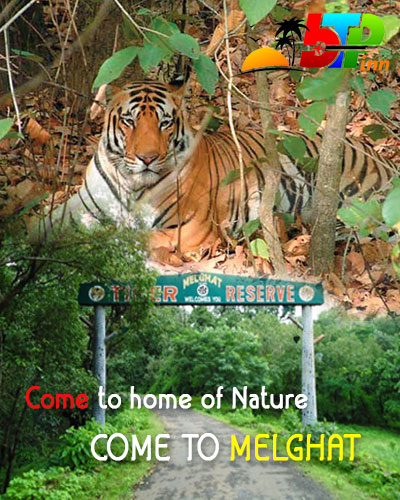Melghat was acknowledge as tiger reserve and was among the initial nine tiger reserves prompted in 1973-74 forming the Project Tiger. It is located at 21°26′45″N 77°11′50″E Coordinates in northern side of Amravati District of Maharashtra State in India. The Tapti river and the Gawilgadh edge of the Satpura reach form the borders of the reserve. In 1985 Melghat Wildlife Sanctuary was created. The Tapi river flows through the northern point of the Melghat Tiger Sanctuary , through dense forest which lies within the waterway of the river structure. Many distinct type of wildlife, both plants and animals, are found here.
History
There are passages in Melghat that atrackers from the north travelled to reach Berar Province, where the Imad Shahi kingdom had been founded in 1484. The historic castles, Narnala and Gawilgarh, protected the main east-west ridge. In 1803, in the Second Maratha battle, Colonel Arthur Wellesley, who later became the Duke of Wellington, concurred the Gawilgarh fort from the Marathas.
Geography
At the northern border of the Amravati district of Maharashtra, on the edge of
Madhya Pradesh, lies the Melghat in the South-western Satpura mountain ridge.
Melghat means bunch of the mountains, which illustrates the region as a vast
province of unending Mountains and nullahas spotted by rough cliffs and vertical
climbs.
The Melghat area was prompted a tiger reserve in 1974. The Meghat Tiger Reserve
split into three distinct Wildlife areas of Sipna, Gugamal and Akot. Currently, the total
area of the sanctuary is around 1677 km2. In Sipna and Gugamal Wildlife, consisting
more than 10 hamlets in the area. In Akot wildlife Division,. all villages are
rehabilitated.

Fauna
The jungle is sticky and muggy, dry deciduous in nature, dominated by teak (Tectona grandis). The sanctury is a waterway area for five major rivers: the Khandu, Khapra, Sipna, Gadga and Dolar, all of which are branches of the river Tapti. The animals mainly found here are Bengal tiger {बाघ } , Indian leopard{ तेंदुआ } , sloth bear { भालू }, Indian jackal { सियार }, sambar, indian bison {गौर } , barking deer{ हिरन }, blue bull {नीलगाय}, deer { चीतल }, antelope {चौसिंघा }, honey badger or ratel {बिज्जू }, flying squirrel { गिलहरी} , wild boar {जंगली सूअर }, baboon {लंगूर}, rhesus monkey{ बंदर}, porcupine {साही}, pangolin { छिपकली}, mouse deer{ चूहा हिरण } , python {अजगर}, otter and blacknaped hare {जंगली खरगोश}.
Population
There are 61 hamlets in the sanctuary , outside the nucleus {core area} . 22 are in
between the cushion area {buffer zone} and 39 in out side of cushion area. (MUA-
Multiple Use Area ). Human habitat in the cushion area and MUA is 11024 and
15642, respectively, as per 1994 census.
The populace are from tribal communities, mainly Korku tribe (80 per cent) and like
Gond, Nihal, Balai, Gaolan, Gawali, Halbi, Wanjari. All populace count on the forest,
for daily domestic necessity like firewood, timber, fodder, medicinal plants, and
produce like fruit, flowers, gum and medicinal plants. Source of income is in from of
labor and agriculture. They strengthen their earnings by collecting non-timber forest
products,. Mahuali flora, seeds like charoli, gumcula, dhawada, tendu-leaves, and
Musali.
Tourism
Melghat, situated in the Amaravati sub-continent {district} of Maharashtra, is a tiger
wildlife sanctuary. Melghat Tiger sanctuary is situated in the Satpura hights, in
Central India, called Gavilgarh Hill. It is 225 km drive from Nagpur towards west. It
was officially confirmed as a wildlife sanctuary in 1967, and was acknowledged as a
tiger reserve in 1974. It was among the maiden nine tiger reserves declared in 1973-
74 under Project Tiger.
Tourism in Melghat is distributed along 4 cores / hamlets. Semadoh, Chikhaldara,
Harisal Shahnur. There are some hotels at Kolkas which is 14 km ahead of
Semadoh.
The closest railway station to reach Chikhaldara, Semadoh, Kolkas, Harisal is
Amravati. Shahnur is closest to Akola. The nearest airport is at Nagpur some 225 km
away.
Travellers can check out Melghat in all seasons, but during the monsoons, starting
mid-July till end of September, bestows the best views. The winters are frosty during
night, and temperature dropping below 5 degrees, gives a feel to be at Kashmir .
The summers are good for wildlife sightings.
Accommodation/ Stays in Melghat, are mostly run by forest department, except the
few hotels and resorts at Chikhaldara. Hotels are comfortable and basic in nature,
suiting the forest atmosphere.
 BTP BCN Group
BTP BCN Group BTP Yatra
BTP Yatra BTP Buses
BTP Buses BCN
BCN